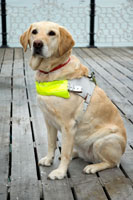
Skip section navigation (navigation may have changed)
Section navigation
Service animals

Service animals do some of the things that people with disabilities cannot do for themselves. A service animal may:
- Guide people with visual impairments (for instance, a Seeing Eye dog)
- Alert people with hearing problems to sounds, like doorbell
- Pull wheelchairs
- Carry and pick up things for people who have a hard time moving around
- Respond to medical crises, such as seizures caused by epilepsy
Most service animals are dogs. But other animals also can be trained to perform tasks for people with disabilities. For instance, miniature horses are trained to guide the blind and pull wheelchairs. Cats can be trained to pick up dropped items and alert people with hearing impairments to important noises.
You can get a service animal through an organization or a private trainer. Sometimes you have to pay for the animal, and sometimes it’s free. You may have to put your name on a waiting list.
Here are some resources:
- Canine Companions for Independence
- Dogs for Deaf and Disabled Americans
- Guide Dog Foundation for the Blind
- Guiding Eyes for the Blind , which also has dogs to help kids with autism
- Leader Dogs for the Blind , which also trains dogs for people who are both blind and deaf
- Dogs for the Deaf
- A list of private trainers provided by the Delta Society, which promotes the health connection between humans and animals
Content last reviewed February 16, 2011
Page last updated October 31, 2013







